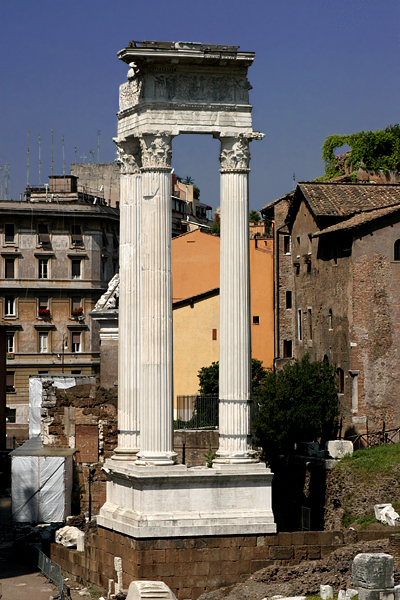

"The pestilence that year kept everything quiet. The duumvirs did many things prescribed by the sacred books to appease the wrath of the gods and remove the pestilence from the people. The mortality, notwithstanding, was heavy both in the City and in the country districts; men and beasts alike perished. Owing to the losses amongst the cultivators of the soil, a famine was feared as the result of the pestilence."
Livy, IV.25
Vowed to Apollo Medicus (the healer) in 433 BC because of a plague and dedicated two years later by an ancestor of Julius Caesar (Livy, IV.29), this was the only temple of Apollo in Rome until the one built by Augustus on the Palatine. The Ludi Apollinares were instituted in 212 BC to honor the god and were celebrated in July. The temple, itself, which was restored or rebuilt several times, received its final restoration by Gaius Sosius, one of Caesar's lieutenants and consul in 32 BC. Although the epithet Sosianus still was used by Pliny in the AD 70s, Sosius was an opponent of Octavian and had sided with Antony at Actium in 31 BC. Given the rich decoration of the cella, it may be that the temple actually was completed by Augustus, who changed the dedication date to his birthday on September 23 and was building his own temple to Apollo on the Palatine, which was dedicated in 28 BC. The frieze, too, depicts a battle against northern barbarians, and Augustus did have a triumph for his victories over the German tribes in 29 BC.

Excavated in 1926-1928, the Corinthian columns, which are from the front, right-hand corner of the temple porch, have been raised on a contemporary travertine and tufa base. They are carved with flutes alternately wide and narrow.
There originally were six columns of Luna marble across the front of the temple porch (pronaos) and two on the sides, as well as seven engaged columns of travertine along the wall of the cella. The capitals have sprigs of laurel, which is sacred to Apollo, beneath the volutes. Laurel branches strung between candelabras with tripod bases and ox skulls (bucrania) also decorate the entabulature.
The cella, itself, was richly decorated with colored marbles and lined with a Corinthian colonnade, the two levels separated by a frieze depicted scenes of battle and a triumphal procession. Between the columns were aediculae or niches for statues. Pliny (XIII. 53, XXXVI.28, 34; XXXV.99) speaks of the temple being filled with works of art, all relating to Apollo, which probably were brought to Rome by Sosius, the most famous of which were the children of Niobide by Scopas or Praxiteles, although even the ancients were not sure.